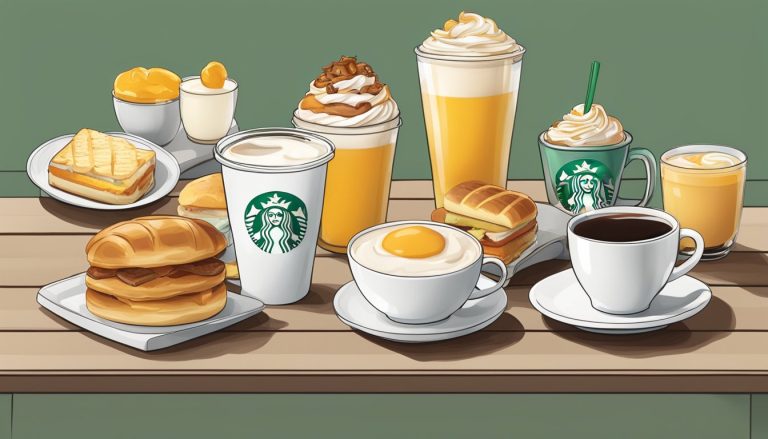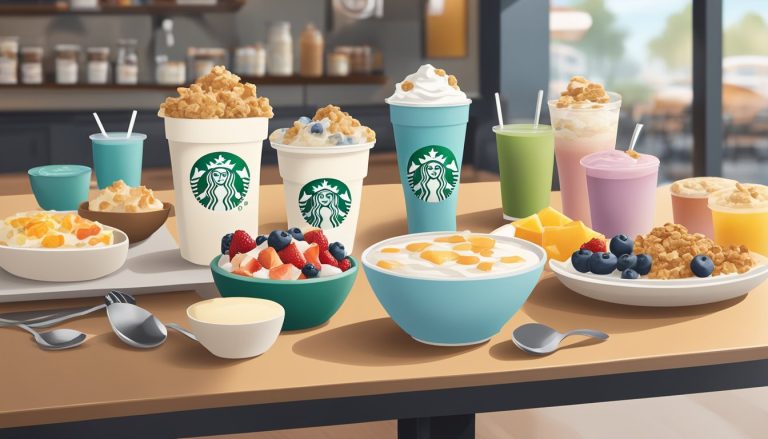Starbucks has long been a pioneer in transforming coffee consumption into a cultural experience. Over the years, the company has expanded its menu to include a variety of breakfast offerings, tapping into the power of nostalgia to attract and retain customers.
The introduction of pastries, sandwiches, and other breakfast items has allowed Starbucks to cater to customers seeking a quick morning meal alongside their coffee. These breakfast offerings often evoke memories of comforting home-cooked meals or childhood favorites, creating an emotional connection with patrons. This strategic use of nostalgia has helped Starbucks maintain its position as a “third place” between home and work, where customers can find both familiarity and novelty.
As Starbucks continues to evolve its menu, the company balances innovation with nostalgia. While introducing new items to meet changing consumer preferences, Starbucks also maintains classic offerings that remind customers of their past experiences with the brand. This blend of old and new keeps the menu fresh while preserving the emotional ties that have made Starbucks a beloved part of many people’s daily routines.
Starbucks’ Embodiment of Nostalgia

Starbucks has skillfully woven nostalgia into its brand identity, leveraging its rich history and cultural impact to create a unique coffee experience. The company’s approach to nostalgia extends from its origins to its current branding strategies.
The Historical Context of Starbucks and Nostalgia
Starbucks’ story began in 1971 at Seattle’s Pike Place Market. Founded by Jerry Baldwin, Gordon Bowker, and Zev Siegl, the company started as a small retailer selling high-quality coffee beans and equipment. This humble origin has become a cornerstone of Starbucks’ nostalgic appeal.
The company’s expansion under Howard Schultz in the 1980s and 1990s coincided with the rise of coffee culture in the United States. Starbucks positioned itself as a “third place” between work and home, fostering a sense of community and connection.
This concept tapped into a collective longing for simpler times and face-to-face interactions. By emphasizing its Seattle roots and commitment to quality, Starbucks created a narrative that resonated with consumers seeking authenticity in an increasingly fast-paced world.
Nostalgia in Starbucks’ Branding and Aesthetic
Starbucks’ branding and aesthetic choices reflect a careful balance between nostalgia and modernity. The iconic green mermaid logo, while updated over the years, maintains a link to the company’s maritime-inspired beginnings.
Store designs often incorporate elements reminiscent of traditional coffeehouses, such as warm wood tones and comfortable seating areas. These touches evoke a sense of familiarity and comfort, even as Starbucks continues to innovate.
The company’s seasonal offerings, like the Pumpkin Spice Latte, tap into nostalgia for traditional flavors and childhood memories. Limited-time menu items create a sense of anticipation and ritual, further strengthening emotional connections to the brand.
Starbucks’ merchandise, including mugs and tumblers, often features designs that celebrate its heritage or local culture, allowing customers to take a piece of the Starbucks experience home with them.
Analyzing Starbucks Breakfast Offerings

Starbucks has leveraged nostalgia and innovation to create a compelling breakfast menu. The company’s strategies focus on product variety and seasonal offerings that resonate with customers’ emotions and preferences.
Product Offering Strategies
Starbucks’ breakfast menu combines classic favorites with innovative options. The company offers a range of hot and cold breakfast sandwiches, pastries, and oatmeal. Protein boxes provide a healthier alternative for health-conscious consumers. Starbucks has expanded its egg bite options to cater to low-carb diets.
The coffee giant continually refines its food offerings based on customer feedback and market trends. In recent years, Starbucks has increased its plant-based options to meet growing demand. The company also emphasizes locally-sourced ingredients where possible, appealing to consumers’ desire for sustainability and freshness.
Seasonal Items and Consumer Nostalgia
Starbucks expertly taps into consumer nostalgia with its seasonal breakfast items. The Pumpkin Spice Latte, introduced in 2003, has become a cultural phenomenon. This specialty coffee drink signals the start of fall for many customers, creating an emotional connection to the brand.
Starbucks extends this strategy to food items as well. Seasonal pastries like the Cranberry Bliss Bar evoke holiday memories. Limited-time breakfast sandwiches featuring seasonal ingredients create a sense of urgency and exclusivity. By rotating these offerings, Starbucks keeps its menu fresh and exciting while maintaining a core of reliable favorites.
The Starbucks Experience
Starbucks has crafted a unique coffee experience that extends beyond just serving beverages. The company focuses on creating a welcoming atmosphere and fostering connections between customers and staff.
Role of Baristas in Crafting the Experience
Baristas play a crucial role in shaping the Starbucks experience. These skilled employees are trained to provide personalized service and create customized drinks. They greet customers by name, remember regular orders, and engage in friendly conversation.
Baristas also contribute to the sensory experience. The sound of grinding coffee beans and steaming milk adds to the ambiance. Calling out customer names for drink orders creates a sense of familiarity and connection.
Starbucks invests heavily in barista training. Employees learn not just coffee-making skills, but also customer service techniques. This ensures consistent quality and service across locations.
Creating Community and the ‘Third Place’
Starbucks aims to be a “third place” between home and work. The company designs stores to be inviting spaces where people can relax, work, or socialize. Comfortable seating, free Wi-Fi, and a warm atmosphere encourage customers to linger.
The concept of community is central to Starbucks’ philosophy. Stores often host local events and showcase local artwork. This helps create a sense of belonging and connection to the neighborhood.
Starbucks has become a cultural phenomenon partly due to this community focus. It’s not uncommon to see people holding meetings, studying, or catching up with friends in their stores. This reinforces Starbucks’ role as more than just a coffee shop, but a community hub.
Consumer Engagement and Loyalty

Starbucks employs strategic initiatives to foster consumer engagement and cultivate loyal customers. These efforts center around personalized rewards and convenient digital ordering options.
Loyalty Programs and Customer Retention
The Starbucks Rewards program stands as a cornerstone of the company’s customer retention strategy. With millions of active members globally, this tiered system incentivizes frequent visits and higher spending. Members earn “stars” for purchases, which can be redeemed for free drinks, food items, and merchandise.
Personalization plays a key role in the program’s success. Starbucks leverages customer data to offer tailored promotions and recommendations, enhancing the perceived value of membership. This approach not only encourages repeat visits but also increases average transaction values.
The program’s digital integration through the Starbucks app further streamlines the customer experience. Members can easily track rewards, place orders, and make payments, creating a seamless interaction with the brand.
Mobile Ordering and Customer Convenience
Starbucks’ mobile ordering feature has revolutionized customer convenience. The app allows customers to place orders in advance, bypassing long lines and reducing wait times. This service particularly appeals to time-conscious consumers, enhancing their overall experience.
The mobile platform also enables Starbucks to gather valuable data on consumer preferences and behaviors. This information informs product development and marketing strategies, allowing the company to better cater to customer needs.
Mobile ordering has proven to be a significant driver of customer loyalty. Regular app users tend to visit Starbucks more frequently and spend more per transaction compared to non-app users. The convenience factor has made the app an integral part of many customers’ daily routines.
Sustainability and Ethical Considerations

Starbucks has integrated sustainability and ethical practices into its core business model. The company focuses on reducing environmental impact and ensuring responsible sourcing of ingredients, particularly coffee beans.
Starbucks’ Commitment to Sustainability
Starbucks has set ambitious targets to minimize its carbon footprint. The company aims to reduce carbon emissions, water usage, and landfill waste across its stores. In 2022, approximately 3,500 Starbucks locations implemented measures to achieve these goals.
Starbucks is working towards making its cups and packaging more eco-friendly. The company has introduced reusable cup programs and is exploring innovative materials for its containers.
Energy efficiency is another priority. Many Starbucks stores now use LED lighting and energy-efficient appliances to reduce power consumption.
Ethical Sourcing of Coffee Beans
Starbucks places a strong emphasis on ethically sourcing its coffee beans. The company has developed its own Coffee and Farmer Equity (C.A.F.E.) Practices, a comprehensive set of guidelines for ethical coffee production.
In 2022, 98% of Starbucks’ coffee was ethically sourced and verified. This commitment extends to fair compensation for farmers and supporting coffee-growing communities.
Starbucks partners with Conservation International to implement sustainable farming practices. These include water conservation techniques and promoting shade-grown coffee to protect biodiversity.
The company also invests in farmer support centers, providing training and resources to coffee growers to improve crop quality and sustainability.
Marketing and Consumer Trends

Starbucks leverages nostalgia in its breakfast offerings while embracing modern marketing tactics. The company balances retro appeal with innovative approaches to engage customers and drive sales.
Leveraging Social Media Buzz and Innovation
Starbucks utilizes social media platforms to generate buzz around its nostalgic breakfast items. The company encourages customers to share photos and memories of classic menu offerings, creating a sense of community and shared experiences.
Instagram and TikTok campaigns feature influencers showcasing vintage-inspired breakfast options, appealing to younger demographics while tapping into older customers’ nostalgia. Starbucks also employs innovative technologies like augmented reality to enhance the nostalgic experience.
The coffee giant introduces limited-time offerings that blend traditional flavors with modern twists. These items often become viral sensations, driving foot traffic and online orders. Starbucks carefully analyzes consumer trends to strike a balance between familiar comfort foods and exciting new creations.
By combining nostalgia marketing with cutting-edge digital strategies, Starbucks maintains relevance in a competitive breakfast market. The company’s approach demonstrates how traditional brands can adapt to changing consumer preferences while honoring their heritage.
Strategic Leadership and Future Outlook

Starbucks’ leadership is guiding the company through a period of transformation and growth. New initiatives aim to reconnect with customers while driving expansion in key markets.
Vision of the CEO and Impact on Growth Strategies
Brian Niccol, Starbucks’ CEO, has outlined bold plans to revitalize the brand. His strategy focuses on enhancing customer experiences and personalizing interactions. Niccol aims to acquire 200,000 Sharpie markers, allowing baristas to write customers’ names on cups again.
This move harkens back to Starbucks’ roots, emphasizing personal connections. The company is also overhauling its marketing efforts to reach a broader audience beyond Rewards members.
Niccol’s approach includes showcasing coffee quality while moving away from discount-driven promotions. This shift aims to strengthen brand value and attract new customers.
Starbucks is investing in store renovations and expanding its global footprint. The company’s “Growth at Scale” agenda prioritizes responsible expansion, balancing profitability with social and environmental considerations.
Despite recent financial results falling short of expectations, Starbucks remains optimistic about its long-term prospects. The leadership team is committed to elevating in-store experiences for both partners and customers.




